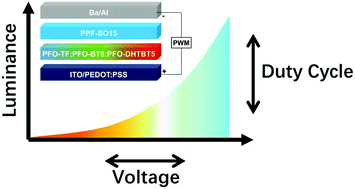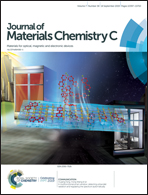White polymer light-emitting diodes with ultra-large color shifts for pulse-width-modulation applications†
Abstract
The ideal white polymer light-emitting diodes (WPLEDs) require stable light-emitting spectra upon the variation of bias or current density, where the color shift is unfavorable, especially towards the practical applications in solid state-lighting. However, the color shift in WPLEDs is beneficial for specific applications such as simulating sunlight and mood-lighting. For a proof-of-concept study, here, we fabricated a set of WPLEDs that exhibited ultra-large color shifts in terms of the 1931 Commission Internationale de L’Eclairage (CIE) coordinate shifting with Δx > 0.21 and Δy > 0.17. These devices contained a blue emissive layer and a yellowish emissive layer, which were fabricated through a semi-orthogonal solution process. Detailed studies revealed that the dependence of the CIE coordinates on bias can be correlated to the variation of energy transfer and charge trapping in the host–guest doping system and the shift in the charge recombination zone. Based on a commercially available pulse-width-modulation-based drive mode, the WPLEDs with independently tunable CIE coordinates and luminance were realized; they exhibit a great potential towards practical applications.



 Please wait while we load your content...
Please wait while we load your content...